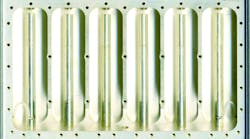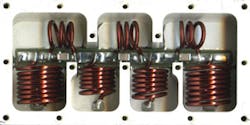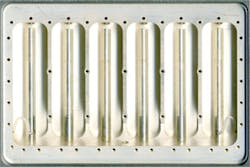This file type includes high resolution graphics and schematics when applicable.
When very high standards of performance and frequency response are required, it is often difficult to achieve the desired specifications by adding a filter component to a pre-existing design. This is the case with military, space, telecommunications, and public-safety systems. All of these applications tend to require reliable performance under a wide range of conditions. A solution to these challenges is to design filter components into a combined assembly, which is known as an integrated filter assembly (IFA; Fig. 1). Considering the demanding specifications of modern applications due to size, weight, and power (SWaP) constraints, many other components are incorporated into the filter assemblies. In fact, an integrated multi-function assembly (IMA) can house amplifiers, mixers, couplers, and other active/passive components.
Filter components tend to be highly reflective circuit elements. As a result, their electrical behavior is very sensitive to the impedances and parasitics at the filter’s internal and external ports. Jon Scoglio, engineering manager with API Technologies, comments, “If you tune a filter component considering an ideal system, and then drop it into the next-level assembly, you hope that everything plays well from an impedance standpoint. But that is never the case.” This scenario requires the careful design of the filter components and IFAs, so that each individual block can be tuned throughout the assembly process for optimized performance. Many factors play into the critical aspects of IFA/IMA designs including materials, interconnect, filter type, added functions, tuning, and application.
The design of IFAs, like any system, is divided into functional blocks and modeled around the most limiting structures. The goal of modeling the filter electrically is to gauge the interaction between the filter elements and the electrical components. This approach enables the up-front analysis of the design, so that some of the adjustment of the filter structure into the surrounding circuitry can be performed preemptively. “The more you can do on the computer, from a modeling perspective, the less you will have to do on the bench,” notes Scoglio. “The better you can model the filter components, the less time—and possibly material waste—you will have downstream when you have physical hardware and prototypes manufactured.” The mechanical portions of the filter are designed using advanced 3D modeling techniques to model the complete structure. Even the filter elements are modeled to scale, so that the IFA can be made as compact as possible if needed. Other desired properties can be optimized using these design techniques as well. The IFA or IMA application heavily influences the design criteria of the assembly.
Filters for military and space applications in particular center around broadband, powerful, and reliable performance under an extreme range of temperature and environmental conditions. An IFA enables a filter to meet such performance criteria by being accurately tuned and compensated for environmental conditions. In addition, the assembly can be equipped with a ruggedized housing that meets environmental criteria. Weight and size can be more readily controlled with an IFA, as there are techniques that can bend filter stages into small and complex shapes. To further enhance the durability and stability of IFAs, laser sealing, low-dielectric-material stabilizers, and temperature-stabilizing elastomers can be added to key areas of the design.
For their part, public-safety radio systems generally differ from military requirements in that they need to have very precise and narrow filter responses around set frequencies. They also have slightly less stringent ruggedness requirements. The narrowband response requirement is caused by the intense spectrum competition around the frequencies in which public-safety radio systems operate. Achieving a high-Q filter response in a small and light footprint is a difficult task with discrete designs, considering the reliability and ruggedness requirements of public-safety systems.
In contrast, the filter requirements for telecommunications applications focus on high-power and extremely high-Q designs. Here, an individual frequency channel—only a few megahertz wide—may need to be filtered. Scoglio comments, “In a lot of the cases, with the crowding of the spectrum, the telecom filters are some of the most complex you can find.” The higher Q or power requirements generally increase the size of the individual filter components. These complex and bulky designs often must fit into a compressed rack-mount profile with high electromagnetic-interference (EMI) specifications. Custom filter assemblies using multi-technology filters and integrated amplifiers/mixers can reduce the part counts needed as well as the overall size of the systems.
Together with other factors, this compacting method makes filter components very dependent upon their mechanical structure and the way they are physically housed. Most IFAs are designed and built in machined metal housings. Naturally, there are tradeoffs between the different metals used for the housing of the assembly. With cavity filters, for example, the cavity is formed by the surrounding housing of the chassis. The behavior of a cavity filter is characterized by the type of metal used, its finish, and plating (if used). Another example is a combline cavity-type filter. Here, the temperature performance of the filter is highly dependent upon the thermal expansion of the metal used in its construction.
The primary metal of choice for IFAs is aluminum, as it is low in both cost and weight. Brass would be the second-most common choice. More specialized metals like stainless steel, Invar, and Kovar follow. For extreme-temperature purposes, it may be necessary to use lower-thermal-coefficient-of-expansion metals like Invar or Kovar. Compared to aluminum, brass offers a slightly better thermal coefficient of expansion and is still fairly cheap. But brass is a much heavier metal than aluminum. For its part, aluminum is lossy. It also is difficult to solder to and must be plated, which adds cost and quality-control challenges. Although brass is solderable, it still needs to be plated for loss or corrosion purposes. Scoglio states, “We are building highly integrated assemblies, where the filters are mechanically laid into the assemblies in a compact way—even bending around corners as you do in the game of Tetris and putting these assemblies in as small a footprint as possible.”
This file type includes high resolution graphics and schematics when applicable.
Construction Particulars
This file type includes high resolution graphics and schematics when applicable.
The level of intricacy of these designs and lack of competent machinery leaves IFAs with predominantly custom construction. IFAs are generally hand-assembled from the component level. Some manufacturers use semi-automation, such as desktop-type conductive reflow machines, to perform some soldering operations in order to set components. On a lumped-element filter, for example, surface-mount capacitors may be soldered to the floor of the housing. This approach will be used if volume dictates the cost of using conduction benchtop reflow machines to perform some of the solder operations. Automation also is rare and sometimes impossible when sophisticated tuning techniques are used to get the highest performance from the filter technology.
Wherever possible, the filter sub-assemblies are tuned by hand, individually, to 50 ohms. To save manufacturing steps, the filter is built and tuned in its own machine-level housing. The filter subassembly is then integrated into the next level of assembly and hand-tuned to the required performance. Such tuning requires skilled technicians, who use network analyzers to observe the performance of the IFA in real time.
Each type of filter requires a different approach to tuning. After all, only certain filter elements can be cost effectively changed in a way that will reliably affect the filter’s performance. With lumped-element filters, a technician manipulates the coils of the inductive-filter elements using a wooden or fiberglass stick at the turns of the inductors. In the case of a cavity filter, a technician is generally turning tuning screws, which allow him or her to adjust the air-loaded capacitances at the end of each resonator rod (Fig. 2). Tuning dielectric resonators may seem like a less delicate operation, as a rotary grinding tool is used to remove the ceramic resonator body while its electrical behavior is observed live.
The filter elements used in an IFA design are chosen by SWaP, electrical properties, and the ability to tune key elements. When considering lumped elements, standard monolithic surface-mount-type capacitors and single-layer capacitors made of alumina or higher-dielectric-constant materials are common. Generally, inductive elements are limited to the types that can be manipulated and tuned, which limits the use of surface-mount wirewound inductors. The inclusion of air-wound inductors or toroids is dictated by the amount of inductance and the design’s size constraints.
Cavity and dielectric-based filters are more dependent upon their physical construction—as an aspect of the housing design. As a result, the manufacturing of the housing becomes part of the tuning process. For cavity filters, the metal rods inside the cavity are acting as the resonant elements. The end of the rod is picking up capacitances to a set screw coming through the chassis wall. Turning the screw adjusts the air gap at the end of the rod and, subsequently, the capacitances. The dimensions of the rod and the metal housing around it are what set the relative frequency response of the filter element.
Regarding dielectric resonators, these filters are constructed of pressed ceramics that are metallized. A cutout section is designed to achieve the specified resonance, and that hole is the resonant element. To tune these structures, grinders adjust the frequency of resonance by removing the metallization from one end of the element. Because this tuning process is a one-way function, skilled technicians are needed to achieve sufficient yields in a manufacturing setting.
“The same type of adjustments will be made in the next level of assembly,” notes Scoglio. “We design the housing in such a way, ideally, that we will have access to the tuning mechanism for the different filter types.” If the filter is designed as a subassembly, consideration must be given to the impedance and tuning of the individual subassemblies within the compound assembly. This approach will enable performance to be optimized. In some cases, the filter components may be integrated into the chassis of the next level of assembly due to space constraints.
In summary, it is good practice to build and tune filters into the IFA’s subassembly and perform coarse tuning with the filter individually at the subassembly level. This pre-tuning can be comprehensive and include all of the tunable components. The subassemblies are mechanically designed. As a result, they can be adjusted within the next level of assembly to account for impedance variations and parasitics in the interconnections between assembly components. Typically, a tuning operation is needed for the launch interconnects, amplifiers, couplers, or other passives in an IMA both before and after the filter components.
This file type includes high resolution graphics and schematics when applicable.



